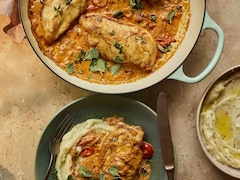Monsoon brings with it the irresistible urge to indulge in lip-smacking street food. The smell of pakoras wafting from a roadside stall, the hiss of hot oil, the spicy aroma of chutneys - all of this becomes even more tempting when it rains. But while the weather might call for comfort food, hygiene becomes a major concern during this season. The increased moisture and humidity can make certain foods breeding grounds for bacteria, which is why it's important to choose your monsoon munchies wisely. Here are some street foods that are generally safe to eat during the rains, provided you pick the right vendor.
Also Read: 7 Healthy Street Foods You Can Enjoy Guilt-Free This Monsoon
Here Are 6 Street Foods That Are Safe To Eat During Monsoon
1. Pakoras and Bhajiyas
No monsoon is complete without a plate of piping hot pakoras. Since they are deep-fried at high temperatures, the risk of contamination is relatively low. Choose vendors who fry them fresh and serve them straight from the kadhai. Avoid pre-fried or reheated options, as they may have been sitting in the open for long. Don't trust your neighbourhood roadside street vendor? Order it online from a hygienic restaurant.
2. Sweet Corn
Sweet corn is a popular snack during monsoon.
Steamed or roasted sweet corn is another popular monsoon snack that is fairly safe to eat. It's cooked at high temperatures, and if the vendor is hygienic and uses clean butter or spices, it's a healthy, tasty option. Opt for lemon-chilli corn or masala corn instead of mayo-laden variants, which may spoil quickly in the rain.
3. Momos (Steamed Only)
Steamed momos can be a safe street food choice if they're freshly prepared. Steaming kills most bacteria, and if the vendor maintains cleanliness in handling and serving, they're generally low-risk. However, avoid fried or tandoori momos from questionable stalls, as they often reuse oil or pre-cook large batches.
4. Idlis and Dosas
South Indian street stalls often churn out fresh idlis and dosas that are safe to consume during the rainy season. The batter undergoes fermentation, which can actually make the food more gut-friendly. Ensure the sambhar and chutneys are served hot and not cold from containers left out in the open. You can easily find these classic South Indian dishes on a food delivery app.
5. Boiled Egg or Anda Bhurji
Eggs are a good monsoon protein, but only when cooked thoroughly. Avoid half-boiled or soft-boiled versions and stick to anda bhurji or boiled eggs that are made fresh in front of you. Make sure the vendor uses clean utensils and doesn't leave ingredients uncovered.
6. Tea and Coffee
Hot beverages like masala chai or filter coffee are monsoon staples. They're boiled before serving, making them low-risk. Just make sure the milk is fresh and not reused throughout the day. Spiced teas with ginger and cardamom are also good for digestion and immunity during this season.
Also Read: Monsoon Diet: 5 Expert Diet Tips To Stay Healthy With Strong Immunity During The Rainy Season
Tea is the perfect drink for rainy days.
Street Food Tips During Monsoon
- Watch the water: Skip any raw chutney or drink made with tap water.
- Go for steaming hot: Foods cooked or served hot are safest.
- Avoid dairy-heavy items: Curd, cream, and cheese spoil fast in humid weather.
- Observe the stall: Choose vendors with clean hands, covered ingredients, and a steady crowd.
So next time it pours, you don't have to resist the pull of your favourite street snacks. Just choose wisely, and enjoy the rain with a warm, delicious bite in hand.
